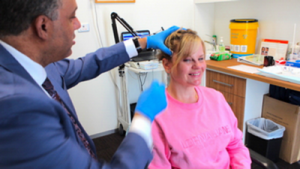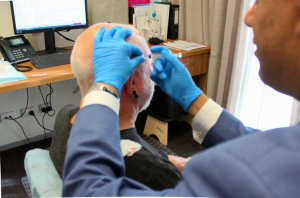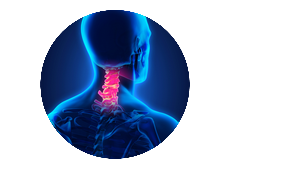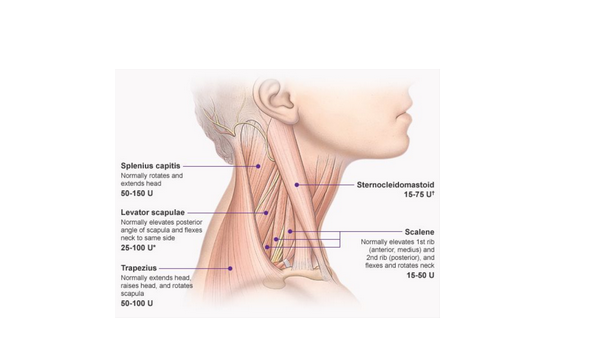INJECTABLE THERAPIES


 WHAT IS INJECTABLE THERAPY?
WHAT IS INJECTABLE THERAPY?
While injection therapy is not a cure for migraines it does represent an effective preventative intervention in many migraine patients. There is good evidence that when it works, injection therapy has a cumulative effect, with better and better response with each cycle administered every 3 months across a year. However, after 2 injection cycles, as per PBS criteria, if no improvement is noticed, the injections should be discontinued.
- It is effective for chronic migraine, with a 70% response rate after 3 injection cycles
- A significant reduction in severe migraine events is seen in treatment responders, with a 90% reduction in emergency department visits
- Significant improvements in headache related disability, resulting in significantly improved functioning, vitality and overall Headache related Quality of Life Assessments can be achieved
- Compliance with migraine prophylactic medications is a major issue, with the need to consume an oral medication every day, or sometimes 2 to 3 times per day. Convenience is superior in this regard with injection therapy, with the injection cycles administered every 12 weeks
- Patients receiving injection therapy also had significantly fewer intakes of triptans (acute therapy), than did placebo groups
HOW CAN WE HELP?
Injection therapy is used to reduce the excess muscle activity caused by dystonia. Injection therapy into the affected muscles often reduces the signs and symptoms to effectively relax excessive muscle contraction.
Treatment may be repeated as often as every three months

WHAT IS CERVICAL DYSTONIA?
Cervical dystonia, also known as spasmodic torticollis, is a rare neurological disorder that originates in the brain. Cervical dystonia is characterised by involuntary muscle contractions in the neck that cause abnormal movements and postures of the neck and head. In some cases, these abnormal contractions may be sustained or continuous; in others, they may be present as spasms that can resemble tremor.
WHAT CAUSES CERVICAL DYSTONIA?
Cervical dystonia is a disturbance in the balance of chemicals in the brain believed to be caused by incorrect messages being sent from the brain to the muscles.
 Types of Neck Dystonia (Cervical);
Types of Neck Dystonia (Cervical);
- Anterocollis – to be pulled forward
- Rotational Collis – to remain upright but be turned
- Laterocollis – sideways, toward either shoulder
- Retrocollis – to be pulled backwards
FAQ
How do you know if you qualify for injectable therapy?
If you suffer from chronic migraines, are over 18 years of age, not pregnant, breastfeeding or planning for a pregnancy in the next 3 months you should consider injection therapy. You should also consider the therapy if at least 3 preventative medications provided from your doctor have limiting side effects or have been unable to provide you with significant benefit.
Preventative medications include: Propranolol, Pizotifen, Candesartan, Topiramate, Amitriptyline, Sodium Valpoate & Verapamil. Whilst Triptans are an effective acute migraine treatment they are not a preventative therapy.
What happens after the first set of injections?
Afterwards patients are able to drive home and resume normal activities. Vigorous neck exercises, neck massage, and or physiotherapy are however discouraged for 24 hours after the procedure. There is good evidence that when it works, injection therapy has a cumulative effect, with better and better response with each cycle administered every 3 months across a year. However, after 2 injection cycles, as per PBS criteria, if no improvement is noticed, the injections should be discontinued.
May I take other medications for headache while I’m receiving injection therapy?
Yes. Prompt treatment of acute migraine headaches with appropriate medications and in a frequency that will not cause medication overuse headaches is advised. Your migraine specialist will provide you with an acute migraine treatment strategy. This will assist the injection therapy to achieve a remission of your chronic migraine back to the episodic form of that headache disorder.
My injection therapy for chronic migraines has been working well, but I’m worried that it will stop being effective, what are the chances of this happening?
A study that sought to answer this question was recently published by Cernuda Morolion, titled ‘Long-term experience with (injection therapy) in the treatment of chronic migraine: What happens after one year?’
- Only in around 1/10 patients did injection therapy lose their clinical efficacy after more than one year of treatment
- There was no failure after the third year of treatment
In 43% of cases, injections can be delayed to every 4 months (16 weeks) after the first year of treatment.

